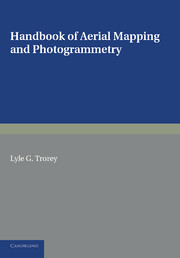Book contents
- Frontmatter
- Dedication
- FOREWORD
- PREFACE
- Contents
- LIST OF TABLES
- Bibliography
- Notation
- CHAPTER 1 PERSPECTIVE PRINCIPLES
- CHAPTER 2 MEASUREMENT OF ANGLES FROM OBLIQUES
- CHAPTER 3 PERSPECTIVE GRID AND FOUR-POINT METHODS
- CHAPTER 4 MEASUREMENT OF HEIGHT FROM A SINGLE OBLIQUE
- CHAPTER 5 VERTICALS: FUNDAMENTAL CONSIDERATIONS OF COVER, PARALLAX AND STEREOSCOPY
- CHAPTER 6 PARALLAX AND ELEVATION CALCULATIONS
- CHAPTER 7 RADIAL-LINE TRIANGULATIONS, GRAPHICAL AND MECHANICAL
- CHAPTER 8 RECTIFICATION MEANS
- CHAPTER 9 SUBDIVISIONS OF AN AIR SURVEY MAPPING OPERATION
- CHAPTER 10 PRINCIPLES OF STEREOSCOPIC PLOTTING INSTRUMENTS
- CHAPTER 11 THE MULTIPLEX PROJECTOR
- APPENDIX 1 STANDARD MAPPING PROCEDURE ROYAL CANADIAN ENGINEERS
- APPENDIX 2 MULTIPLEX AND STEREOPLANIGRAPH: CONSIDERATIONS GOVERNING MINIMUM CONTOUR INTERVAL
- APPENDIX 3 THE KELSH PLOTTER
- INDEX
APPENDIX 2 - MULTIPLEX AND STEREOPLANIGRAPH: CONSIDERATIONS GOVERNING MINIMUM CONTOUR INTERVAL
Published online by Cambridge University Press: 05 June 2016
- Frontmatter
- Dedication
- FOREWORD
- PREFACE
- Contents
- LIST OF TABLES
- Bibliography
- Notation
- CHAPTER 1 PERSPECTIVE PRINCIPLES
- CHAPTER 2 MEASUREMENT OF ANGLES FROM OBLIQUES
- CHAPTER 3 PERSPECTIVE GRID AND FOUR-POINT METHODS
- CHAPTER 4 MEASUREMENT OF HEIGHT FROM A SINGLE OBLIQUE
- CHAPTER 5 VERTICALS: FUNDAMENTAL CONSIDERATIONS OF COVER, PARALLAX AND STEREOSCOPY
- CHAPTER 6 PARALLAX AND ELEVATION CALCULATIONS
- CHAPTER 7 RADIAL-LINE TRIANGULATIONS, GRAPHICAL AND MECHANICAL
- CHAPTER 8 RECTIFICATION MEANS
- CHAPTER 9 SUBDIVISIONS OF AN AIR SURVEY MAPPING OPERATION
- CHAPTER 10 PRINCIPLES OF STEREOSCOPIC PLOTTING INSTRUMENTS
- CHAPTER 11 THE MULTIPLEX PROJECTOR
- APPENDIX 1 STANDARD MAPPING PROCEDURE ROYAL CANADIAN ENGINEERS
- APPENDIX 2 MULTIPLEX AND STEREOPLANIGRAPH: CONSIDERATIONS GOVERNING MINIMUM CONTOUR INTERVAL
- APPENDIX 3 THE KELSH PLOTTER
- INDEX
Summary
Refinements of optical design and of the calibration and matching of projector lenses have resulted in improved performance of multiplex equipment.
It has been explained that the optical train of the multiplex consists of three parts, air camera, reduction printer, and projectors. The design and calibration of the equipment are directed to obtaining, as nearly as may be, a distortion-free image. This means that the distortions arising in each unit should nicely balance out, and further implies accurate matching of the projectors, one to another.
If this end is attained (within readable limits) there are uncompensated only the following: variation in distortion characteristics of lenses of the same family, and distortions due to differential film shrinkage.
Air-camera lenses which differ by more than the allowable tolerance from the standard distortion for which the reduction printer was designed may be rejected, at least when working at H/1000.
This leaves differential film distortion as the bugbear.
Good operators can read sharp multiplex models to plus or minus 0.03 mm. or better. Now, differential distortion of 0.008 mm. on the 6 in. negative plane, at 30° on the base-line, will cause a heighting difference of this amount. It is apparent therefore that the instrument can reflect differential film distortions of magnitudes which do occur.
It is equally apparent that it can also reflect differences in distortion of air lenses of the same family.
How closely the optical design and calibration compensates the various lens distortions, quite frankly the writer does not know. What can, however, easily be checked is how closely the model spot heights agree with corresponding ground elevations. That is to say the combined effect of residual optical distortions, plus film distortion, can readily be measured. The writer has conducted numerous tests of this nature upon well-known makes of equipment and has found the arithmetic mean deviation to be about 1/4000 of the flight altitude. This means that the actual mean precision of the equipment is about one-tenth of a millimetre at model scale.
- Type
- Chapter
- Information
- Handbook of Aerial Mapping and Photogrammetry , pp. 172 - 173Publisher: Cambridge University PressPrint publication year: 2013



